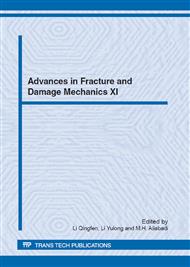p.161
p.165
p.169
p.173
p.177
p.181
p.185
p.189
p.193
Pressure Pipe Damage: Numerical Estimation of Point Load Effect
Abstract:
The most relevant loading conditions for real polymer pipe systems are not only internal pressure, but also loading caused by sand embedding including bending or different kinds of point loads. It has been shown that service lifetime of buried pipes can be reduced especially due to stress concentration caused by external point loads. If the pipe is loaded locally the stress is concentrated here and a crack can initiate at this position or the existing crack can be affected by corresponding stress redistribution. In the paper the effect of the hard indenter, Poissons ratio, hoop stress level and pipe wall thickness on the crack shape was estimated using numerical simulations of the creep crack propagation based on finite element method. Relation between crack length and crack width was found and expressed by simple relationship. A deeper understanding of the point load effect in order to prevent unexpected failure of the pipelines is of paramount importance for pipeline design.
Info:
Periodical:
Pages:
177-180
Citation:
Online since:
November 2012
Authors:
Price:
Сopyright:
© 2013 Trans Tech Publications Ltd. All Rights Reserved
Share:
Citation:


